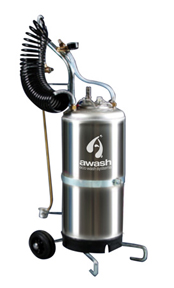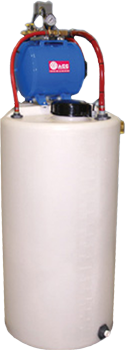
By Jack Jackson

In today’s world of environmental concerns and impacts of each industry, the bus industry is now giving serious thought to the level of impact on the environment. We are now looking at ways to be efficient in tires, engines, fuel consumption and aero-dynamics.
Washing your bus can be another dynamic way to be environmentally sound and save money as well. Let’s put some myths to bed and pass on some ideas on how to be green while saving money and improving your image when it comes to washing your buses.
Today there is technology available to meet any needs and desires of your washing requirements, be it budget or environmentally based. Generally, the most popular automatic machinery to wash vehicles today consists of automated drive through, rollover and walk-around units. These automated systems enable a bus to be washed and rinsed in less than five minutes. Available as well are water reclamation and recycle systems to offset environment concerns and save on water costs.
However, there are many operators still using the manual pressure washer and hand brush scrub system, taking up to 30 minutes or more to wash and rinse. Reliable labor, time costs and wash consistency are the major frustrations with any operator utilizing a manual handwash system.
Let’s take a look at facts about bus washing:
Washing buses in your parking lot
Do you know some municipalities and states have banned washing cars on the street and even your driveway? Yes, that water goes directly to the storm sewer and immediately into your local water source, whether it is a stream, river, lake or ocean. If you are washing in your parking lot, where does that drain go? Most likely, it goes directly to the closest aquatic system in your area.
The chemicals being used for washing end up in the local aquatic systems. Even if you use the proper “biodegradable soaps” you are still sending grease, oil, gasoline and other contaminants with that wash water into the water shed.
The Environmental Protection Agency suggests washing your vehicles on gravel or grassy surfaces, since Mother Nature knows how to neutralize those contaminants in the soil. However, this can’t be efficient for any bus operator that has multiple vehicles to wash. The surface would obviously become inundated with water and mud, so there has to be more thought put into large vehicle washing.
There are technologies available to capture your wash water in your parking lot, recycle and reuse this water. Also there are companies that will capture and dispose in the proper sewer system so as not to pollute your environment.

Washing inside your building
Washing inside your building, in the majority of cases, means you are tapped into your municipal water sewage system, thus the wash water is being sent to your treatment facility. While this does help the environment, there are costs.
The municipality has to clean this water. Also, your company or building is paying for water that’s possibly on a meter. Check your water bill and understand it.
Are you paying for sewage discharge as well? Many companies do not realize that there is a water charge in and many times there is a “water out” charge. Some areas meter water in and out, with a hefty charge for water discharge. You are paying for water in and then paying again for water out, sometimes twice the amount to discharge.
Today’s technology allows for water treatment systems at your wash bay. There are many systems available that allow you to capture your water, clean it and reuse for washing. This would allow a zero discharge, thus saving money and the environment.
Handwashing buses
A three-quarter-inch water hose dispenses 17 gallons of water per minute. Do the math and washing a bus for 30 minutes equates to 510 gallons of water. Each gallon weighs 8.3 pounds, so you may have used over two tons – or 4,200 pounds – of water to wash that bus.
Whether you are washing inside your building or outside on your parking lot, the use and cost of water can be a major hidden expense for your facility. Do the analysis and find a major saving, especially when you look at your cost-per-gallon of water.
Today’s technology for cleaning buses, no matter if you are using an automatic system, a walk-around single brush unit, pressure washer or old fashioned hand brush, can be a green initiative in your company. It’s a matter of education of water usage, techniques and analysis. With water shortages and environmental impacts this is a growing concern, and one long ignored.
The cost of water varies across the continent, thus it can have different impacts depending on your location. Do you draw water out of a well or lake? We hear from these customers that we don’t pay for water, so not a concern. We have to believe there is a cost to all of us eventually.
For most of us the municipality supplies our water through pipes to our facility. Take a minute to examine the water bill and come up with a cost-per-gallon of water. This is not easy, but it’s necessary to determine your cost-per-vehicle of washing.
After determining the cost of water you will have to capture the cost of labor, chemicals and supplies, like brushes and cloths, etc. It is understandable why only 1 percent of companies know the actual cost of washing a bus.
Overall, bus washing has much more of an impact than most operators’ take time to consider. There is a major affect to both the environment and the bottom line of every company, city and municipality. Take time to consider your footprint on the environment. BR
Jack Jackson is President of Awash Systems in Toronto, Canada. He can be reached at jjackson@awashsystems.com. Find Awash Systems at www.awashsystems.com or call (800) 265-7405.

Another cost to consider is the filtration cost of the water that was used to wash the bus. After cleaning, the water needs to be treated so as not to harm the environment by discharging it untreated.